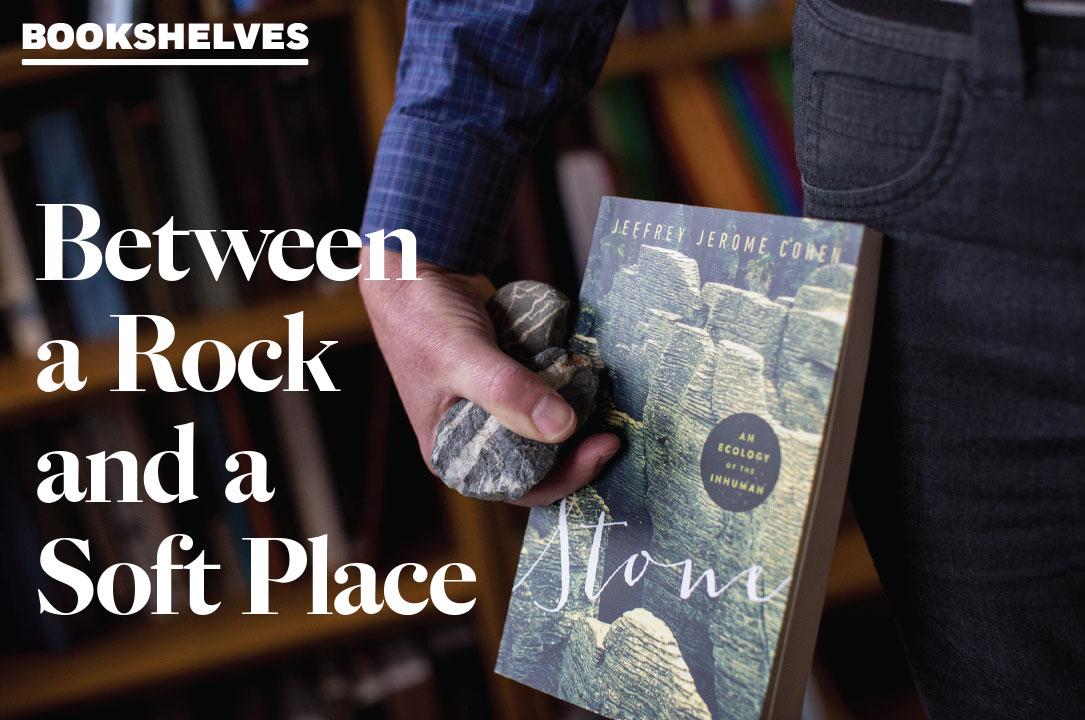Between a Rock and a Soft Place - Spring 2016
(Photo/Logan Werlinger)
Expressions like "heart of stone" and "stone cold" suggest that living,
breathing, feeling people share little with rocks. Humans are
thought the stars, while stones are props—at times useful,
photogenic and often confounding (e.g., stumbling blocks). In this
book, Jeffrey Jerome Cohen explores how "human" stone can be.
By Menachem Wecker, MA '09
In 2006, while finishing a book about race, GW English professor Jeffrey Jerome Cohen noticed how heavily anti-Semitism during medieval times relied upon geological terminology, for example, calling Jews "stone hearted." That set off his active study of the subject, though he feels that his new book, Stone: An Ecology of the Inhuman (University of Minnesota Press, 2015), chose him, and that it did so years before he realized its grip.
"Maybe the book started earlier when my parents refused to buy me a Pet Rock, because they told me it wasn't really alive," he says. "I was one of those kids who returned from every trip to the beach with a pocket full of wave-smoothed pebbles."
His scholarship came to focus on the ways that "time unfolds for humans at a much swifter tempo than it does for much of our planet." He wondered whether earlier cultures entrusted their monuments to stone because they noticed it operated on a slower time. "They knew it would endure," he says.
And then Dr. Cohen went on a family trip to the neolithic structure in Avebury, in England, not far from Stonehenge, and he saw his children place their hands on the rocks. "Stories were being imparted by the encounter," he says. The more he studied both medieval and contemporary texts, the more he realized that stone has worked so well for memorials not because it's inanimate, but because it's "lively."
"We trust it to endure, to resonate with our history and narratives. Stone writes without words. It transmits. Medieval people knew this well," he says. "So I delved into the origins of geology in medieval lapidaries as well as the use of gems in medicine and magic. Stone is a powerful, active substance."
Dr. Cohen structured the book around anecdotes, many involving his family, offering a narrative navigation through a scholarly discussion of the topic. "I tried to craft the book so that it would be readable by anyone who is drawn to stone," he says.
One eye-opening realization in Dr. Cohen's research was the etymology of the word "calculus," which comes from the Latin word for small stones used for counting. Across human history, stone has been mankind's unwitting sidekick, serving as "windbreaks for fire, as axes for war or industry, as a substance for lasting art," he writes. In every "rocky encounter," stone wasn't inert but proved its "ability to intensify our desires and possibilities."
Lessons in Censorship: How Schools and Courts Subvert Students' First Amendment Rights (Harvard University Press, 2015)
Catherine J. Ross, professor of law
Penned for lay parents and constitutional law experts alike, this book opens with a high school official's declaration— evocative of Dante's "Abandon all hope" inscription above hell— that "You lose all constitutional rights once you enter a school building." Dr. Ross calls the official's position "as clueless as it was surreal," but adds that laws governing school speech can confuse even judges. This book sets the historical and legal record straight.
The Quotable Amelia Earhart (University of New Mexico Press, 2015)
Edited by Michele Wehrwein Albion, MA '91
Two things about Amelia Earhart are widely known: She was the first woman to fly solo over the Atlantic, and her plane later vanished over the Pacific in 1937. But she also was a "tireless advocate for women's rights" and a "wise, well-spoken adventurer," Ms. Albion writes. And in some of the quotations collected here, Ms. Earhart is both: "There is no cause inherent in her nature which would make a woman inferior to a man as an air pilot."
A Poverty of Words (Prolific Press, 2015)
Frederick Pollack, adjunct professor of creative writing
The publisher's description of the author's voice—belonging "to neither the navel-gazing mainstream nor the poststructuralist avant-garde"—aptly sets the tone for these 92 poems. One imagines a future, "politely annoyed" Buddha; another begins, "How often I've wanted to write something/ without symbols and with only the flimsiest/ metaphors. Then buses, pills, dogs and leaking/ pipelines would at last be themselves ..."
The Last Summer at Chelsea Beach (Mira Books, 2015)
Pam Jenoff, BA '92
Drawing on her experiences working in Poland for the U.S. State Department, during which she aided
the preservation of Auschwitz and the restitution of Polish Jewish property, Ms. Jenoff—a law professor at Rutgers University—tells in this novel the story of a young refugee. Adelia Montforte flees fascist Italy in 1941 and arrives in America worried that she is utterly alone. Even a stray dog sniffing at garbage "seemed to somehow know where it was going." Her aunt and uncle surface, but as one might expect, acclimating into this new melting pot won't be as easy as it seems.
War in the Shallows: U.S. Navy Coastal and Riverine Warfare in Vietnam: 1965-1968 (Naval History and Heritage Command, 2015)
John Darrell Sherwood, MPhil '93, PhD '95
Dr. Sherwood, a Navy historian, zeroes in on a neglected aspect of the Vietnam War: Naval "brown water" (river) and "green water" (coastal) operations, as opposed to the "blue water" (oceanic) work more typical of the 20th century. At its height, the Navy's river and coastal operations included more than 30,000 sailors and 350 vessels. "Vietnam was a decidedly low-tech, manpower intensive operation—an anathema to a Navy focused on fleet operations and cutting edge technology," he writes.
Other Spring Features
Card Catalog
A niche collection of baseball cards makes it to Cooperstown.
Pattern Recognition
Ding Ren, MFA '09, looks across cultures for "patterns that are both foreign and familiar."
The Rockwell from the Vault
Brady Art Gallery exhibition showcases little-or never-seen art from GW’s permanent collection.











